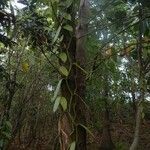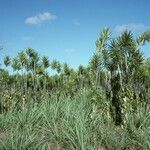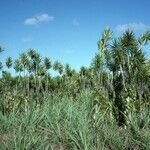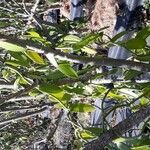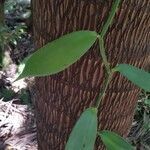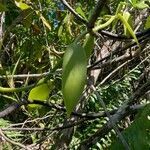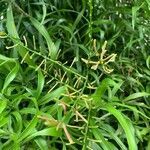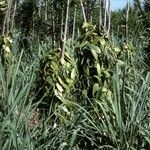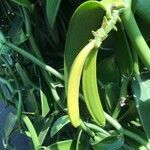A climbing orchid. The vine is fleshy and climbs by means of roots. It can climb to 10-15 m high. It is 1-2 cm across and flexible but easily broken. There are 5-15 cm between nodes. It is often trained to a lower height to allow easier pollination and harvesting. Aerial roots arise from the stem opposite the leaves. These are white and 2 mm across. They attach to supports. It has long pointed fleshy leaves. They have almost no stalk and can be 8-25 cm long by 2-8 cm wide. The tip of the leaf is pointed and the base is rounded. The flowers are greenish yellow and large and waxy. They occur in groups of up to 30 in the axils of the leaves. The fruit is a long fleshy pod with small black seeds inside.
Scandent branched leafy herbs. Leaves 8-23 cm. long and 2-8 cm. broad, narrowly lanceolate to elliptic-oblong, acute or acuminate, fleshy. Raceme short, 5-7 cm.-: long, axillary; bracts 5-10 mm. long, oblong, obtuse or subacute. Sepals 4-7 cm. long and 1-1.5 cm. broad, linear to oblanceolate, obtuse or acute. Petals similar to the sepals but smaller. Lip 4-5 cm. long and 1.5-3 cm. broad, with longitudinal, verrucose lines or papillae and a tuft of pubescence on the-disc. Column about 3 cm. long, pubescent dorsally. Capsule ("bean") up to about 20 cm. long and 1 cm. in diameter.
Stems long and vine-like, green, rooting at nodes. Leaves scattered, elliptic to lanceolate, 100–220 × 50–75 mm, bright green, shiny, leathery. Racemes condensed, axillary, 20–75 mm long, 5–20-flowered. Flowers opening singly, often not opening widely, 60–75 × 40–60 mm, greenish yellow, strongly fragrant. Labellum tubular, 50–70 × 25 mm, broadly flared at apex, with a long narrow basal stalk and a central cluster of hair-like lobes, margins crinkled. Fruit a cylindrical curved bean-like capsule to 20 cm long.
